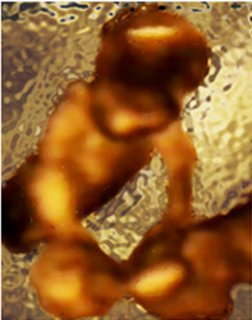
To accept the fact that after fertilization has taken place a new human has come into being is no longer a matter of taste or opinion. The human nature of the human being from conception to old age is not a metaphysical contention, it is plain experimental evidence
If you want to believe that a baby in the womb is not a person, then, you have to ignore the plain experimental evidence. LeJeune’s quote comes from 1981, and since them, more and more experimental evidence has been stacking up to show that a baby in the womb is most definitely a human being. The latest evidence to be added to the pile comes from ultrasound investigations of twins in the womb.
Umberto Castiello and his colleagues studied five pairs of twins during their 14th and 18th weeks of development in the womb. They used four-dimensional ultrasonography to study how the twins moved. They showed that the twins touched themselves, touched the uterine wall, and touched each other. However, the touches that they directed towards each other seemed more purposeful and had longer durations. The ultrasonic image at the top of this post, for example, shows one twin caressing the back of the other. This kind of interaction, according to the researchers, is not accidental. It is deliberate.2
One thing they noticed is that from the 14th to the 18th week of development in the womb, the percentage of times the twins touched themselves or the uterine wall decreased, but the percentage of times they touched each other increased. In other words, the interaction of the twins increased as their neurological development increased. The authors conclude:
These findings force us to predate the emergence of social behaviour: when the context enables it, as in the case of twin foetuses, other-directed actions are not only possible but predominant over self-directed actions.
Now think about what this means. Almost 30 years ago, Dr. LeJeune explained that genetics tells us babies in the womb are fully human. With this analysis, however, we now have another indicator that tells us the same thing. When the opportunity arises, a baby in the womb will socially interact with another baby in the womb. He or she will stroke the other baby’s back, stroke the other baby’s head, etc. In other words, not only is the baby fully human from a genetic point of view, he or she is fully human from a social point of view.
Those who want to view a baby in the womb as just a mass of tissue or only a “potential” human life now have even more science they are forced to ignore.
REFERENCES
1. as quoted in Norman L. Geisler, Christian Ethics: Options and Issues, Baker, 1989, p. 149.
Return to Text
2. Umberto Castiello, et al., “Wired to Be Social: The Ontogeny of Human Interaction,” PLoS One, October 7, 2010 (Available Online)
Return to Text

Wow. Thanks so much for posting this!
I am glad that you liked it, Kyle!
How significant will this be?
Firstly the data is very subjective (Particularly “more purposeful”). It would be easy enough to disregard it under the pretext that the nervous system is not developed enough for meaningful interhuman contact at that age so it MUST be a fluke.
Given that 87% of UK abortions are performed under 12 weeks (I don’t know how the US or other countries compare but expect it’s similar.) they couldn’t really be condemned under this piece of research, and at that age the same doubts about the very possibility of such social interaction must be magnified still further.
Still it would put a bit of a crimp in Peter Singer’s justification of abortion in that the foetus is a Homo Sapien but not a person.
Josiah, I think the study makes a strong case for purposeful, other-directed movements. They actually time the duration of the touches, and they find that the touches are noticeably longer when they are other-directed. Also, remember that the percentage of other-directed touches increases significantly as the neurological system develops. This could be coincidental, of course, but it fits very nicely with the idea that the social interaction develops with the nervous system.
I certainly agree that this current research doesn’t address the social status of a baby at less than 14 weeks in the womb. However, I would expect that as time goes on, more research will occur in this area. Given the fact that the brain starts to form in week 3 and starts to differentiate in week 4, it is possible that the social development starts significantly earlier than 14 weeks. If nothing else, however, I think this research makes a strong case for a social human being at least within the 14-18 week window. That, in itself, is important.
Dr. Wile, you have to be kidding. Five sets of twins “makes a strong case for a social human being at least within the 14-18 week window.” How can that be strong evidence, whatever was observed?
And does four-dimensional ultrasonography just use time as the standard fourth dimension?
No, I am not kidding, and neither are the authors. Remember, they state:
Indeed, 100% of twins studied in the womb exhibit social behavior. That is very strong evidence. This isn’t a statistical study. We aren’t trying to determine relative risk or something like that. We are observing what happens when the possibility of social interaction presents itself in the womb, and in every case studied, the babies in the womb are social. This is why the authors say they are FORCED to predate the emergence of social behavior.
You are correct about the fourth dimension. Three-dimensional ultrasounds take a snapshot. Four-dimensional ultrasounds record three dimensions of space and how they change as a function of time.